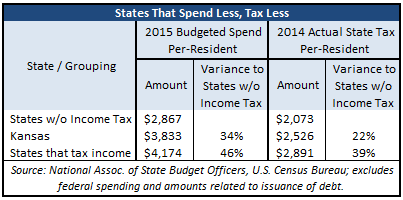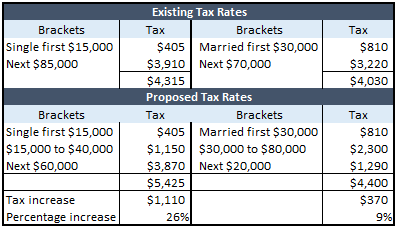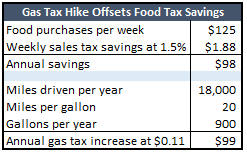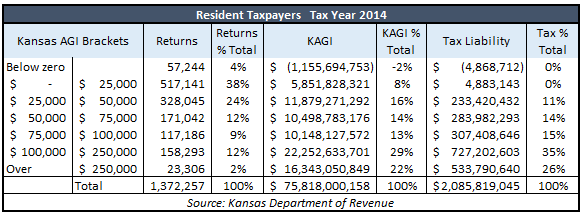An $820 million tax hike was proposed by special interest groups last week so that Kansas government can continue to operate very inefficiently and those who profit from excess government spending can grab more of your money. That’s not how they describe it, of course; they claim that government couldn’t possibly survive without a massive tax increase, the wealthy should pay their fair share and they want to help the poor by reducing the sales tax on food. The truth is that state governments that operate more efficiently do quite nicely on less revenue per-resident, the wealthy are paying a disproportionate share of the tax burden in Kansas, their plan arguably increases the tax burden on low income families and it most certainly does so on middle income families.
True to form, Kansas Action for Children, Kansas National Education Association (teacher union), Kansas Organization of State Employees (another government union) and Kansas Contractors Association (road builders) refuse to provide any data to support their proposal, and also true to form, media dutifully reported their claims without asking for any documentation.
When one begins to examine the data, however, it’s easy to understand why those special interest groups refuse to substantiate their claims. Very little of it stands up to scrutiny and when media lets them get away with making unsubstantiated claims, it only encourages unethical behavior.
The unions, highway contractors and other special interests don’t even bother trying to justify higher spending – they just want more. School funding set another record last year even without counting KPERS and is 40 percent above long term inflation. Highway contractors and others may want to spend more, but Department of Transportation reports show more money was spent on highway projects in the last two years than at least in recent history and highways are in good condition. These are some of the same people who took legislators to task in 2015 for implementing what was then the largest tax increase in Kansas – but now these government fronts want to stick Kansans with a tax hike more than double that amount because, you know, government needs it.
In reality, Kansas can balance its budget by going from being morbidly inefficient to just grossly inefficient. Mitch Daniels, president of Purdue University and former Indiana governor said it best: “This place was not built to be efficient. [But] you’re not going to find many places where you just take a cleaver and hack off a big piece of fat. Just like a cow, it’s marbled through the whole enterprise.” He was speaking of Purdue but his explanation fits all forms of government. The challenge is finding enough legislators with the political will to stand up to special interests and say ‘no’ to an $820 million tax hike – or any tax increase for that matter.
States that spend less, tax less
Every state provides the same basic services but those that do so at better prices can have lower taxes. It’s not access to tourism or natural resources, it’s simply a matter of spending; the more government chooses to spend to provide a service, the more it must tax.
The adjacent table reflects the most currently available data on state spending and taxation. States that tax income budgeted to  spend 46 percent more per-resident than the states without an income tax, which leads to state taxes per-resident being 39 percent higher. Kansas spends 34 percent more per-resident and even after tax reform, taxes 22 percent more per-resident.
spend 46 percent more per-resident than the states without an income tax, which leads to state taxes per-resident being 39 percent higher. Kansas spends 34 percent more per-resident and even after tax reform, taxes 22 percent more per-resident.
General Fund spending last year was $1.068 billion higher than if it had been increased for inflation since 1995. General Fund tax revenue is also running well ahead of inflation but not enough to keep up with spending.
Tax hike hits low and middle income citizens
The proposed increase in marginal rates will especially impact single, young professionals as income above $40,000 would be taxed at 6.45 percent instead of 4.6 percent and result in an $1,100 tax increase for someone earning $100,000. A single filer at that income level would see a 26 percent jump in their tax liability and a married couple’s income tax would increase by 9 percent. (Note: the original version of this post over-stated the dollar amount of tax increase; we apologize for the error).
 And it’s also likely that many of those with AGI below $30,000 would also see a net tax increase. Proponents says their plan would give relief to low income people with a small reduction in the sales tax on food but they take that all back with an 11 cents per gallon increase in gasoline taxes. A family spending $125 per
And it’s also likely that many of those with AGI below $30,000 would also see a net tax increase. Proponents says their plan would give relief to low income people with a small reduction in the sales tax on food but they take that all back with an 11 cents per gallon increase in gasoline taxes. A family spending $125 per  week on food would save $98 per year, but they would pay $99 per year in extra gas tax if they drove 18,000 at 20 miles per gallon. And if they had two cars, they would lose even more even if each car only was driven 12,000 miles.
week on food would save $98 per year, but they would pay $99 per year in extra gas tax if they drove 18,000 at 20 miles per gallon. And if they had two cars, they would lose even more even if each car only was driven 12,000 miles.
But wait, there’s even more. An increase in gasoline taxes will be passed on to consumers in higher prices (like, trucks delivering food to grocery stores), so those who can least afford it will also pay higher prices for groceries and other taxable goods.
Proponents of an $820 million tax hike may talk a good game about caring for low and middle income families, but in reality, it’s just lip service.
High-income earners pay a disproportionate share on income tax
While ‘fair share’ is a subjective term, the data shows that those with higher incomes are already paying a disproportionate share of income taxes. The top 2 percent of filers have 22 percent of AGI but are paying 26 percent of the individual income tax. The next highest 12 percent have 29 percent of AGI but are carrying 35 percent of the tax load. The bottom 42 percent, on the other hand, have 6 percent of AGI and pay just 0.001 percent of income tax. It would be interesting to hear how the income tax distribution is somehow unfair.

Removing the LLC pass-through exemption
There’s a legitimate fairness discussion regarding the exemption on pass-through income but if fairness is the issue, all of the fairness issues should be on the table…including but not limited to sales tax exemptions for certain industries and products, exempting the majority of government employees’ pensions from income tax, charging owners of commercial and industrial property 2.2 times the effective tax rate of homeowners and handing out subsidies to a few employers in the name of economic development.
But legislators must be aware that putting that tax back on business will also negatively impact job growth, as pass-through entities are responsible for most of the new jobs created. Some of the pass-through job additions are attributable to C-corporations that converted to pass-through status but most likely fewer than the number of new proprietors added, which aren’t included in the Census database; their employment data is provided by the Bureau of Labor Statistics which excludes proprietors and farm workers.[i] The Kansas Department of Revenue reports that only 3.3 percent of C-corporations converted and the total number of W2s for all C-corporations declined by 10,396. Even if every W2 decline resulted from a conversion, the job transfer would still be less than the 15,134 new proprietors reported by the Bureau of Economic Analysis.[ii]
Conclusion
Ronald Reagan said it best: “”The most terrifying words in the English language are: I’m from the government and I’m here to help.” Kansas Action for Children, the government unions and the highway contractors really just want to help themselves to more of your money.
_________________
[i] A small number of proprietors listed in the Census database are IRS designations, which says it treats LLCs “…as either a corporation, partnership, or as part of the LLC’s owner’s tax return (a “disregarded entity”). Specifically, a domestic LLC with at least two members is classified as a partnership for federal income tax purposes unless it files Form 8832 and affirmatively elects to be treated as a corporation. And an LLC with only one member is treated as an entity disregarded as separate from its owner for income tax purposes (but as a separate entity for purposes of employment tax and certain excise taxes), unless it files Form 8832 and affirmatively elects to be treated as a corporation.” https://www.irs.gov/businesses/small-businesses-self-employed/limited-liability-company-llc
[ii] BEA report of new proprietors per SA25N downloaded November 28, 2016




